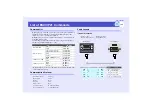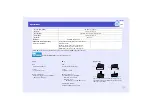
131
Glossary
Glossary
User’s Guide
SNMP
An abbreviation for Simple Network Management Protocol, which is the protocol for monitoring and controlling devices such as routers and
computers connected to a TCP/IP network.
Squeeze mode
To reduce the width of a 16:9 wide-screen video image, record the video image as 4:3 in the video software. Setting the aspect ratio to 16:9 on the
projector will restore the video image to 16:9 wide-screen format.
sRGB
An international standard for colour intervals that was formulated so that colours which are reproduced by video equipment can be handled easily by
computer operating systems (OS) and the Internet.
Subnet mask
This is a number which defines, from the IP address, the number of bits used in network addresses of assigned networks (subnets).
SVGA
A type of video signal with a resolution of 800 (horizontal) × 600 (vertical) dots which is used by IBM PC/AT-compatible computers.
S-Video
A video signal which has the luminance component and colour component separated in order to provide better image quality.
It refers to images which consist of two independent signals: Y (luminance signal), and C (colour signal).
SXGA
A type of video signal with a resolution of 1280 (horizontal) × 1024 (vertical) dots which is used by IBM PC/AT-compatible computers.
Sync.
(Synchronization)
The signals output from computers have a specific frequency. If the projector frequency does not match this frequency, the resulting images will not be
of a good quality. The process of matching the phases of these signals (the relative position of the crests and troughs in the signal) is called
"synchronisation". If the signals are not synchronized, problems such as flickering, blurriness and horizontal interference can occur.
TKIP
Abbreviation for Temporal Key Integrity Protocol. This is an encoding method used for
. The encryption key is renewed after a certain period of
time to make it harder to break the encryption code.
Tracking
The signals output from computers have a specific frequency. If the projector frequency does not match this frequency, the resulting images will not be
of a good quality. The process of matching the frequency of these signals (the number of crests in the signal) is called "tracking". If tracking is not
carried out correctly, wide vertical stripes will appear in the projected images.
Trap IP address
This is the IP address of the messaged computer used for error notification in SNMP.
USB
An abbreviation for Universal Serial Bus. USB is an interface for connecting personal computers to peripheral devices which only support relatively
low data transmission speeds.
UXGA
A type of video signal with a resolution of 1600 (horizontal) × 1200 (vertical) dots which is used by IBM PC/AT-compatible computers.
VGA
A type of video signal with a resolution of 640 (horizontal) × 480 (vertical) dots which is used by IBM PC/AT-compatible computers.
WEP
This is an abbreviation of Wired Equivalent Privacy. This is a security method which encrypts data during transmission.
Data communication cannot be performed unless the sending and receiving machines are registered with the same encryption key by the WEP.
WPA
Abbreviation for Wi-Fi Protected Access. This is an encryption standard that improves security which is a weak point of
is used as the
encryption method.
XGA
A type of video signal with a resolution of 1024 (horizontal) × 768 (vertical) dots which is used by IBM PC/AT-compatible computers.
YCbCr
The carrier signal which is contained in the colour bar signal used in modern TV transmissions. The name comes from the Y (luminance) signal and
the CbCr (chroma (colour)) signals.
YPbPr
The carrier signal which is contained in the colour bar signal used in high-definition TV (HDTV) transmissions. The name comes from the Y
(luminance) signal and the PbPr (colour difference) signals.
Summary of Contents for EMP-830
Page 1: ...User s Guide ...










































